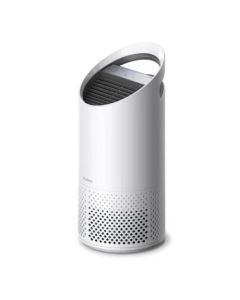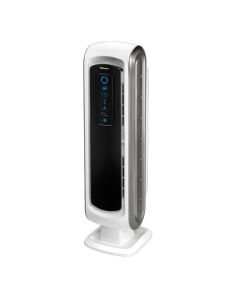Air Purifier Buyer's Guide
There are several different kinds of air purification methods. This guide will provide a general overview of the most popular methods available on the market today. It will cover the types of pollutants that air purifiers are designed to target, the particle sizes and where COVID-19 falls in the scale, how the size of these particles become more dangerous the smaller they get. We will also discuss the types of purifying actions that these machines use to clean the are of these particles, and the pros and cons of each method. And lastly, we will show you some of the best air purifiers for different use cases, such as small rooms (personal, home, or office spaces), huge spaces (cafeterias, yoga studios, and open-space offices), and everything in-between.
TARGET POLLUTANT
There are 2 types of pollutants air purifiers target: particles and gaseous. Both types of particles can be dangerous, and both require various techniquies to properly filter. Below you will find some of the common pollutants that fall into each type.
1. PARTICLES
- Viruses
- Bacteria
- Mold Spores
- Pollen
- Dust
- Smoke Residue
- Etc…
2. GASEOUS
- VOCs
- Carbon Monoxide
- Nitrogen Dioxide
- Ozone
- Radon
- Formaldehyde
- Etc…
PARTICLE SIZES


Large Particles
Mostly captured by mucous membranes of the nose and throat.
Inhalable Particles
< 10 µm (called PM10) can enter the lungs.
Fine Particles
< 2.5 µm (called PM2.5) can penetrate into alveoles.
Ultrafine Particles/Nanoparticles
< 0.1 µm (100 nm) can be absorbed directly into the bloodstream.
According to the World Health Organization (WHO),
these are the most dangerous particles.


PURIFYING ACTIONS
There are 5 types of purification actions used in most air purifiers today: HEPA, carbon, ion, UV, and PCO. In fact, many models offer multi-point, combined technologies to cover various impurities. Below we've outlined the pros and cons of each air purification method. We've also indicated which action targets the various types of pollutants.
1. HEPA
Target: Particles | Method: Fibrous filter
| Pros | Cons |
| High-efficiency | Does not filter microparticles, like viruses and bacteria. Effective down to 0.3µm |
| Most common air purifier | Regular filter replacement |
| Changing the filter releases trapped particles back into the air | |
| Does not remove gasses or odors. |
2. Carbon
Target: Gaseous | Method: Fibrous filter
| Pros | Cons |
| Neutralizes odor, VOCs, gasses | Does not filter particles |
| Common; often combined with HEPA, ION, and UV systems | Regular filter replacement |
| Effectiveness varies on gas |
3. ION (Ionisation)
Target: Particles | Method: Canister or Cell
| Pros | Cons |
| Low power consumption | Slower filtration process |
| Low maintenance/canister replacement is infrequent | Reputation from 1st release in the 90’s |
| No collection of particles |
4. UV Light (UVC Light)
Target: Particles/Microorganisms | Method: Canister or Cell
| Pros | Cons |
| Destroys airborne microbes (micro-size) including viruses, mold, bacteria, dust mites | Slow air flow required to work effectively |
| Deactivates microbes; renders them harmless | No collection of matter |
| Low maintenance/canister replacement is infrequent | Lamp replacements |
5. PCO "Photocatalytic Oxidation"
Target:Gaseous | Method: Canister or Cell
| Pros | Cons |
| Deactivates harmful gasses, renders them harmless | Risk of carbon monoxide; ensure systems are certified |
| Works for large variety of gas pollutants | No collection of particles |
| Low maintenance/canister replacement is infrequent | Extended time required to filter the air |
CHOOSING AN AIR PURIFIER
What customers look for in an air purifier will entirely depend on their industry. Those who often experience high traffic, such as in government buildings, will often look for all-encompassing air purifiers that target viruses, smoke dangers, and more. Corporate offices, however, without much visitor traffic may want to focus more on allergens that protect their staff.
In general, professional organizations and individuals will look at the (1) square footage, (2) run time, (3) target and target size, (4) and the price of a system before making a decision.
Medical facilities may require a deeper look into purification systems that includes getting their own HVAC team involved with the “air changed per hour” and average people in a given space.
No matter the customer, they may use multiple units to cover their unique square footage and room layouts. We can work directly with our partners and our customers to find the perfect placement of multiple units in larger facilities.
SMALL ROOMS
Up to 1,000 square feet
MEDIUM ROOMS
1,000–2,000 square feet
2,000+ square feet
LARGE ROOMS
2,000+ square feet
Hi there!
We want to give you $10.
Sign up for Exclusive Email Offers
Success! You're now on the list. You'll start receiving Exclusive Email Offers shortly.
Please copy and use promo code KLEMAILQ121 in your cart.*
* Offer valid once per customer on orders of $50 or more
$10 OFF your first order of $50 or more

























